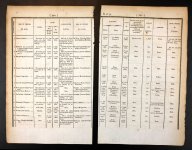Taphrospilus
Well-known member
I open an extra thread as in here...
... wasn't only Hombron discussed.
As per today HBW Alive:
As in Collection building in ichthyology and herpetology p. 66 Extract here:
I support the year 1798 as birth date. See also here p. 33 of 51 birth 26 Germinal an VI in 6 Arrondissement Paris. I think this time the The Eponym Dictionary of Birds here is correct.
Link Hombron, Jacques Bernard (1800-1852)?
... wasn't only Hombron discussed.
As per today HBW Alive:
hombroni
Jacques Bernard Hombron (1800-1852) French surgeon naturalist in the Pacific 1837-1840 (Actenoides, syn. Chalcophaps stephani).
As in Collection building in ichthyology and herpetology p. 66 Extract here:
Hombron, Jacques Bernard (1798-1852) Born on 15 April 1798 in Paris. Naval surgeon from 1821. After being stationed in Guadeloupe, then the port of Brest, he took part as surgeon- major on the Astrolabe during the voyage to the South Pole and Oceania under the command of J. S. C Dumont d'Urville (1837-1840). Employed in Paris at at the Museum from 1840 to 1848 to attend to the collections brought back by the expedition, he participated in the publication of the voyage by Dumont d'Urville. After two cruises between 1848 and 1850, he was appointed s assistant chief physician in Senegal in 1851; he stayed there a short while and died aboard the Ferdinand while sailing back to France, on 16 October 1852.
I support the year 1798 as birth date. See also here p. 33 of 51 birth 26 Germinal an VI in 6 Arrondissement Paris. I think this time the The Eponym Dictionary of Birds here is correct.








